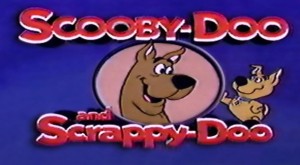
But then what happened? Then, the geniuses behind the Scooby Doo machine threw a wrench into the cogs—and his name was Scrappy Doo. We were led to believe that the show was set in a universe in which dogs could kinda-sorta talk and kinda-sorta walk on two legs, and then here comes this new dog who speaks perfect English, without some kind of off-the-wall speech impediment, and how not only can walk and run on two legs, but who can box like a pro.
You would think that we, the audience, would have a problem with this. And some of us did. But you know what? I really didn’t. I accepted this. I never even justified it to myself by saying, “Oh, I see! In this universe, dogs do talk and act like perfect, hairy little humans. It’s just that Scooby is developmentally disabled. It all makes sense now!” No, I didn’t say anything like that at all when I was a child. I just said, “Huh, Scrappy can talk and Scooby can’t. I accept this without question!”
Well, I’m older now, and wiser, and I realize that not all TV dogs are made alike. But is there a way we could possibly categorize these canine critters? Like, say, in a chart?
As President Obama says, yes. Yes, we can.
A dog-human spectrum, huh? My first thought, naturally, was a simple one-axis sliding scale. On one end would be the most dog-like dogs, and on the other would be the most anthropomorphized pooches.
Turns out, this work was already done for me. The champions at TVTropes came up with a sliding scale of anthropomorphism that looks something like this:
On the far left is the “Intellectual Animal,” a dog that acts like a dog and cannot speak to humans. Now, these dogs are still smart and can save Timmy from a well, and often these dogs can talk to each other or think in English so the non-fluent dog speakers in the audience can understand them. Some “Intellectual” dogs include dogs like the dogs from The Incredible Journey and the canine casts of 101 Dalmatians and Lady and the Tramp.
Second from the left is the “Speech Impaired Animal.” These dogs can kinda-sorta talk like humans but will often be misunderstood. Some “Speech Impaired” dogs include Scooby Doo, Astro, and Inspector Gadget’s Brain.
In the middle of the scale is the “Talking Animal.” These animals talk like humans, and, importantly, can talk to humans, but they still act like animals in many ways. Some “Talking” dogs include Wile E. Coyote (though he doesn’t talk that frequently), Droopy Dog, and Dug from Up.
Second to the right on this scale is the “Funny Animal.” These animals look like animals but talk and act like humans. A dog that fits here is Brian from Family Guy.
Finally, on the far right is the “Humanoid Animal.” These animals talk and act like humans, and they almost look like humans, too (even though, ostensibly, they are still animals). The best dog example of a “Humanoid Animal” is Goofy.
The most I looked at this scale, though, the less useful it seemed. The TVTropes people seemed to be conflating acting human and talking human, which to me seem different enough to be plotted on two separate axes. The TVTropes scale doesn’t seem to even work that well for TVTropes, as Snoopy the dog is listed under “Intellectual Animal,” “Talking Animal,” and “Funny Animal.” A dog scale that can’t figure out where Snoopy goes is majorly flawed in my book.
Another problem with the TVTropes scale is that there doesn’t seem to be enough difference between a “Funny Animal” and a “Humanoid Animal.” Sure, Goofy may look slightly more human than Family Guy’s Brian, but that is a superficial difference. They both talk, read, eat human food. You could argue that Goofy is more “Humanoid” because he wears clothes, but “Funny Animals” Brian and Rowlf often wear clothes, too. It just depends on the occasion.
Thus I felt it necessary to make my own scale. There are two axes: the “acts like a dog or like a human” axis and the “talks like a dog or like a human” axis. Notice that there are two “grey areas’ on the talking axis; I differentiated between dogs that talk to humans but speak like Scooby Doo and dogs that talk or think like humans to the human audience but can’t (usually) speak to humans within their own universe.
Et, voila:
Pluto and Goofy: Still polar opposites.
Next time on “Mlawski writes dumb posts about anthropomorphism in the media”: So, uh, can Gonzo really talk to Camilla, or is he schizophrenic, or what?
